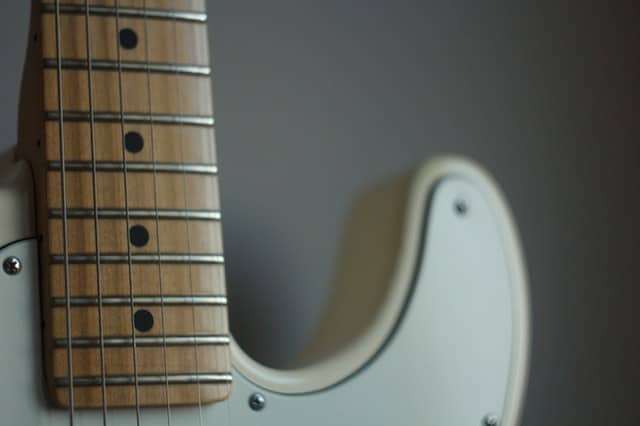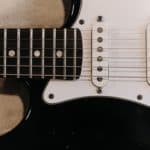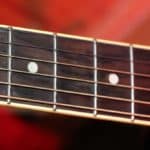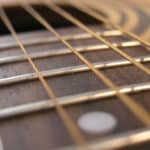We’ve all had days when we sit down to play and relax and something is just off.
Maybe the muse doesn’t feel like visiting, maybe it’s your mood, or perhaps everything isn’t kosher with your instrument.
If it keeps happening time after time it’s probably a good idea to take a look at your frets and see if there is work to be done. And if so, then what is the solution?
If your guitar frets are in need of repair I recommend always choosing a fret dress as long as the frets are still tall enough to be filed down and reshaped. The exception is if you want to nip the problem in the bud and get your guitar refretted with stainless steel fret wire.
It depends on the age of the guitar and prior work done but hopefully, you have more than one option.
These types of maintenance can get pricey very fast so a lot of this will depend on how much the guitar is worth or if you have any emotional attachment to it.
I don’t recommend trying to refret a guitar yourself but if you have a cheap guitar that needs a fret dress it might be a good opportunity to invest in some files and learn a new skill.
What does a total refret mean?
A total refret involves pulling/sliding the old fret wire out of the fretboard, usually with the application of heat to loosen any glue used in the installation.
New fret wire is added and then must be trimmed down and filed smooth along the edges of the fretboard. It’s a major repair and can cause damage to your fretboard wood and binding if the frets don’t come out cleanly.
A partial refret is also possible if you tend to play “cowboy chords” a lot and don’t use the upper fretboard much.
What is a guitar fret dress?
Having a fret dressed is also referred to as leveling or fret crowning.
To get a good tone and sustain your frets should have a small “peak” on the crown (the area of the fret that is above the fretboard) so that only a small portion of the fret is in contact with your string.
If there is too much contact you can have fret buzz as the string vibrates against the fret(s) forward of where you are pressing down.
So if your frets are damaged or flat you can usually have them reshaped with a new crown but sometimes they have to be leveled first and that means more money.
How to know if your guitar needs its frets fixed?
Unless you spend a lot of time looking closely at your fret wire, you will probably first notice problems either by sound or touch.
If you are getting a lot of annoying fret buzz, lack of sustain or your guitar’s notes seem out of tune at different points on the fretboard, you may just need a setup but you should examine your frets’ condition to make sure.
Or if you try to bend a string and find that it’s caught in a rut worn into the fret then a setup isn’t going to fix that and it’s time for repair.
Visually you should be on the lookout for damage such as flattened or pitted frets as well as uneven heights among the different frets.
Is there something you can do to preserve your frets from wear?
Obviously how hard you press with your fretting hand will make a difference in the condition of the fret crowns.
If you usually play really heavy strings or if you learned to play on an acoustic guitar you could be pressing harder than you need to on an electric guitar with nine or ten gauge strings. But I learned to play on a gristly Fender acoustic and I know that muscle memory can be a hard habit to break.
If you play slide guitar you should also try to make contact only with the strings so as not to smash the slide across the crowns of the frets.
And then there are capos; when you use a capo you are firmly pressing the strings into one of your frets and this can cause nasty grooves in the metal.
Even if you are careful, some fret wear is normal over the course of an instrument’s lifetime so having to get your frets re-crowned doesn’t mean that you abused a guitar.
How to know what kind of work you need to be done on your frets?
Basically, I think you should stick to leveling and crowning your frets whenever possible, not only for the cheaper cost but also for the lower risk of damage to your fretboard.
But if you wear out your frets quickly and need to have the crowns redone many times then your frets can get low and it’s time to have the frets replaced.
Your guitar tech or luthier can measure the fret height and tell you whether dressing your frets is still an option.
Now that stainless steel fret wire is becoming more popular and is harder than the traditional nickel alloy type, some players are just switching to stainless steel so they don’t have to worry about wearing out their frets.
Steel is also more time-consuming to work with so you will pay more to have this done but it’s something to consider for the long-term benefit.
How much would fret work on a guitar cost?
Here are some estimates of the charges you might be dealing with if you need to have your frets repaired:
- Full fret recrown: $40 + $70 – $80 setup
- Full fret level and recrown: $100 – $150 + $70 – $80 setup
- Full refret with unbound neck: $375 – $455 (setup included)
- Full refret with bound neck: $440 – $525 (setup included)
As you can see a lot of instruments in the lower and mid-tier price range won’t even warrant repair most of the time.
But what about the video where Phillip Mcknight installed stainless steel frets in a $75 guitar you ask?
Well, that was obviously done as a gimmick, he could do the work himself and he made money from the video.
What can happen if you don’t maintain your guitar frets?
Well, it’s not like the fret police are going to knock on your door if you don’t repair your guitar.
These days Big Brother sees and hears everything but I don’t think he cares about your musical instruments unless you play too loud.
Now my favorite guitar has some light fret wear after many years but it’s not enough to bother me and it isn’t causing any overt problems.
But if you are already having noticeable issues, your intonation and buzzing problems will eventually become worse and deep rivets in your frets (like from a capo) will really affect your playing.
Fretwork is very expensive and you may put it off as you choose but keep in mind that if you decide to fix a guitar to play better or sell later, it’s likely the prices will have gone up.
In the meantime just treat your favorite guitar like a lady (or gentleman) and think twice before slapping a capo on it.

Hello there, my name is Ramiro and I’ve been playing guitar for almost 20 years. I’m obsessed with everything gear-related and I thought it might be worth sharing it. From guitars, pedals, amps, and synths to studio gear and production tips, I hope you find what I post here useful, and I’ll try my best to keep it entertaining also.





